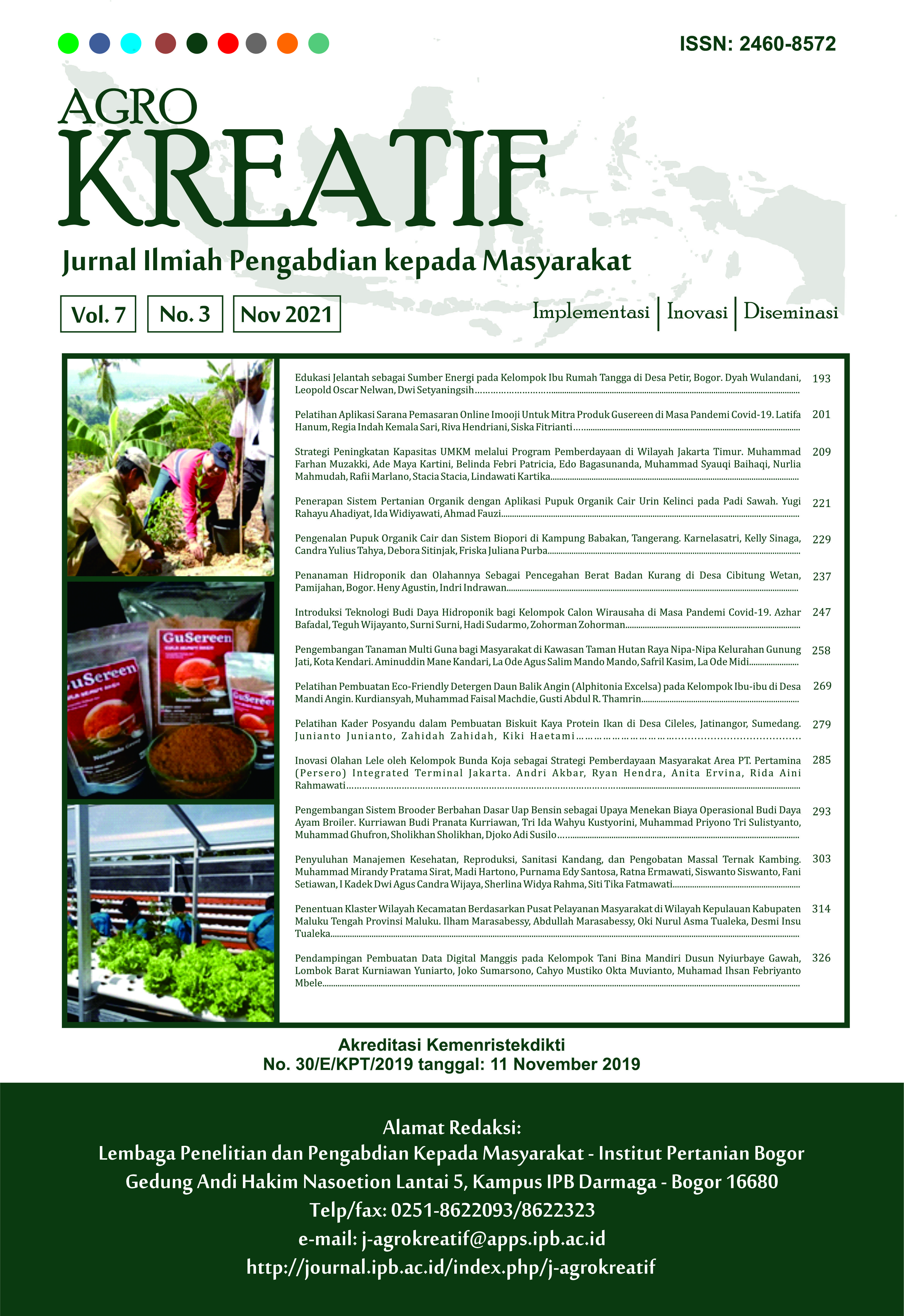Pengembangan Tanaman Multi Guna bagi Masyarakat di Kawasan Taman Hutan Raya Nipa-Nipa Kelurahan Gunung Jati, Kota Kendari
Abstract
The people of Gunung Jati Urban Village, Kendari District, Kendari City have a relatively low economic level amidst the increasing demand. The agricultural products obtained by the community are still considered unable to meet the needs of life. In addition, they are located in the area around the Nipa-Nipa Grand Forest Park (GFP) which is relatively steep and critical, so there is great concern if the community is cutting trees that could threaten forest sustainability. Therefore, the purpose of this service are 1) To provide understanding to farmers about the importance of developing multi-purpose plants and 2) Realizing forest conservation by providing multi-purpose plant seeds to be planted on community-owned land. The method of implementing the program is community-based, namely through multi-purpose plant cultivation training accompanied by assistance with counseling and discussions. The results of this service are 1) The understanding of farmers has begun to increase, namely about 18 people (72%) who already have a very good understanding of developing MPTS plants and 2) The success of planting can be seen from the percentage of seeds that grow and develop by 90% which is part of from vegetative conservation. Lack of public awareness in preserving the Tahura Nipa-Nipa including maintaining the plants that have been given, because economic pressure is still a serious obstacle. Therefore, there is still ongoing assistance with socialization and the addition of multi-purpose plant seeds in the next program.
Downloads
References
Awang SA, Andayani W, Hmmah B, Widayati WT, Affianto A. 2002. Hutan Rakyat: Sosial Ekonomi dan Pemasaran. Yogyakarta(ID): BPFE Yogyakarta.
Baskorowati L. 2014. Budidaya Sengon Unggul (Falcataria moluccana) untuk Pengembangan Hutan Rakyat. Kerjasama Badan Penelitian dan Pengembangan Kehutanan, Balai Besar Penelitian Bioteknologi dan Pemuliaan Tanaman Hutan, dan Direktorat Jenderal Bina Usaha Kehutanan. Bogor (ID): IPB Press.
Birgantoro BA, Nurrochmat DR. 2007. Pemanfaatan Sumber daya Hutan oleh Masyarakat di KPH Banyuwangi Utara. Jurnal Manajemen Hutan Tropika. 13(3): 172–181.
Jazuli A. 2015. Dinamika Hukum Lingkungan Hidup dan Sumber Daya Alam dalam Rangka Pembangunan Berkelanjutan. Jurnal Rechtsvinding. 4(2): 181–197. https://doi.org/10.33331/rechtsvinding.v4i2.19
Mando LOAS, Hasani UO, Midi LO, Bana S. 2017. Potensi dan Struktur Tegakan Jati di Resort Polis Hutan (RPH) Madampi Kabupaten Muna Barat. Dalam: Prosoding Seminar Nasional Kuantitatif Terapan. Kendari (ID). 8 April 2017.
Marpaung S, Afifuddin D, Budi U. 2015. Inventarisasi Tanaman Mpts (Multy Purpose Tree Species) di Daerah Tangkapan Air Danau Toba Provinsi Sumatera Utara. [Internet]. [Diakses pada: 16 Oktober 2017]. Tersedia pada: http://download.portalgaruda.org/article.php?article=438278&val=4112&title=INVENTARISASI%20TANAMAN%20MPTS%20(MULTY%20PURPOSE%20TREE%20SPECIES)%20DI%20DAERAH%20TANGKAPAN%20AIR%20DANAU%20TOBA%20PROVINSI%20SUMATERA%20UTARA.
Gubernur Sulawesi Tenggara. 2014. Peraturan Daerah Provinsi Sulawesi Tenggara Nomor 6 Tahun 2014 Tentang Pengelolaan Taman Hutan Raya Nipa-Nipa.Kendari (ID). Pemerintah Provinsi Sulawesi Tenggara.
Menteri Lingkungan Hidup dan Kehutanan. 2015. Peraturan Menteri Lingkungan Hidup dan Kehutanan Republik Indonesia Nomor: P.33/MenLHK-Setjen/2015 tentang Pedoman Pembangunan Kebun Bibit Kesatuan Pengelolaan Hutan.Jakarta (ID). Kemen LHK-HK.
Purnawan R. 2006. Pemanfaatan Sumber daya Hutan Sebagai Ekoturism Berbasis Kemasyarakatan. Surili. 2(39): 14.
Rustam. 2011. Taman Hutan Raya Nipa-Nipa sebagai Paru-Paru dan Penyangga Lingkungan Kota Teluk, Kendari dan Kabupaten Konawe, Provinsi Sulawesi Tenggara. [Internet]. [Diakses pada: 15 Oktober 2017]. Tersedia pada: http://tamanhutanrayanipanipa. blogspot.com/2011/05/tahura-nipa-nipa-sebagai-paru-paru.html.
Subarna T. 2011. Faktor yang Mempengaruhi Masyarakat Menggarap Lahan di Hutan Lindung: Studi Kasus di Kabupaten Garut Jawa Barat. Jurnal Penelitian Sosial dan Ekonomi. 8(4): 265–275. https://doi.org/10.20886/jpsek.2011.8.4.265-275
Suryaningsih WH, Purnaweni H, Izzati M. 2012. Persepsi dan perilaku masyarakat dalam upaya pelestarian hutan rakyat di Desa Karangrejo Kecamatan Loano Kabupaten Purworejo. Jurnal Ekosains.4(3): 27–38.
Sudia LB, Hasani UO, Mando LOAS. 2017. Bimbingan Teknis Pemanfaatan Pekarangan dengan Multy Purpose Tree Species (Tanaman Multi Guna) untuk Kelestarian Hutan dan Kesejahteraan Masyarakat di Kelurahan Gunung Jati, Kota Kendari. Dalam: Laporan Hasil Kegiatan Pengabdian kepada Masyarakat. Pengabdian Mandiri. Kendari (ID): Universitas Halu Oleo.
Sumanto E, Takandjandji M. 2014. Identifikasi Pemanfaatan Hasil Hutan oleh Masyarakat: Upaya Konservasi Sumber Daya Genetik dan Sosial Budaya. Jurnal Bulletin Plasma Nutfah. 20(1): 27–40. https://doi.org/10.21082/blpn.v20n1.2014.p27-40
Presiden Republik Indonesia. 1990. Undang-Undang Republik Indonesia Nomor 5 Tahun 1990 tentang Konservasi Sumberdaya Alam Hayati dan Ekosistemnya. Jakarta (ID). Pemerintah Negara Republik Indonesia.
Yasir M. 2014. Sikap Sosial Masyarakat Desa Hutan Terhadap Kawasan Suaka Margasatwa Tanjung Peropa Di Kecamatan Laonti Kabupaten Konawe Selatan. [Skripsi]. Kendari (ID): Universitas Halu Oleo
Zulaifah S. 2006. Pemanfaatan Sumber daya Hutan Bersama Masyarakat untuk Pengembangan Kawasan Hutan Regaloh di Kabupaten Pati Jawa Tengah. [Tesis]. Semarang (ID): Universitas Diponegoro
This work is licensed under a Creative Commons Attribution-NonCommercial 4.0 International License.



















